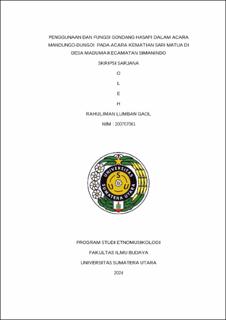| dc.contributor.advisor | Fadlin | |
| dc.contributor.advisor | Ginting, Yoe Anto | |
| dc.contributor.author | Gaol, Rahuliman Lumban | |
| dc.date.accessioned | 2024-10-29T08:40:42Z | |
| dc.date.available | 2024-10-29T08:40:42Z | |
| dc.date.issued | 2024 | |
| dc.identifier.uri | https://repositori.usu.ac.id/handle/123456789/98436 | |
| dc.description.abstract | This study aims to thoroughly analyze the usage and functions of gondang hasapi in the Mandungo-Dungoi ceremony during the Sari Matua death ritual in Maduma Village, Simanindo District. Gondang hasapi is a traditional musical ensemble of the Batak Toba tribe that plays a significant role in various traditional ceremonies, including death rituals. The Mandungo-Dungoi ceremony itself is part of the series of traditional rituals conducted in the context of the death of Sari Matua, an individual who has complete offspring. The research method used is qualitative with an ethnographic approach, allowing the researcher to deeply understand this cultural phenomenon. Data collection was carried out through direct observation, in-depth interviews with traditional leaders, traditional music experts, and local community members, as well as relevant literature studies. Data analysis was performed using descriptive-analytical techniques to identify various aspects of the use and functions of gondang hasapi in this context. The results of the research reveal that gondang hasapi is not only used as an accompanying musical instrument but also as a sacred communication medium with ancestral spirits. The music produced by gondang hasapi is believed to convey messages of respect and prayers to the deceased's spirit and accompany their journey to the afterlife. Additionally, gondang hasapi functions to express grief and solidarity among the surviving community members. Through its distinctive rhythm and melody, gondang hasapi helps create a solemn and respectful atmosphere during the ceremony.This research confirms that gondang hasapi holds significant cultural value in Batak Toba society, particularly in death rituals. The social function of gondang hasapi is also evident in its ability to strengthen social bonds among community members through collective participation in traditional ceremonies. | en_US |
| dc.language.iso | id | en_US |
| dc.publisher | Universitas Sumatera Utara | en_US |
| dc.subject | Gondang Hasapi | en_US |
| dc.subject | Mandungo-Dungoi | en_US |
| dc.subject | Sari Matua | en_US |
| dc.subject | Batak Toba | en_US |
| dc.subject | Death Ritual | en_US |
| dc.title | Penggunaan dan Fungsi Gondang Hasapi dalam Acara Mandungo-Dungoi pada Acara Kematian Sari Matua di Desa Maduma Kecamatan Simanindo | en_US |
| dc.title.alternative | Use and Function of Gondang Hasapi in the Mandungo-Dungoi Event at the Death of Sari Matua in Maduma Village, Simanindo District | en_US |
| dc.type | Thesis | en_US |
| dc.identifier.nim | NIM200707061 | |
| dc.identifier.nidn | NIDN0020026107 | |
| dc.identifier.nidn | NIDN0006036310 | |
| dc.identifier.kodeprodi | KODEPRODI91201#Etnomusikologi | |
| dc.description.pages | 85 Pages | en_US |
| dc.description.type | Skripsi Sarjana | en_US |
| dc.subject.sdgs | SDGs 4. Quality Education | en_US |


